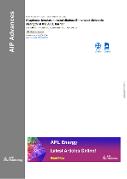Graphene-insulator-metal diodes: Enhanced dielectric strength of the Al2O3 barrier

Publication date
2024Published in
AIP AdvancesVolume / Issue
14 (9)ISBN / ISSN
ISSN: 2158-3226ISBN / ISSN
eISSN: 2158-3226Metadata
Show full item recordCollections
This publication has a published version with DOI 10.1063/5.0223763
Abstract
We studied the transport properties of graphene-insulator-metal tunneling diodes. Two sets of tunneling diodes with Ti-Cu and Cr-Au top contacts are fabricated. Transport measurements showed state-of-the-art non-linearity and a critical influence of the top metals on the dielectric strength of the tunneling barrier. X-ray photoelectron spectroscopy indicated two methods for enhancing the dielectric strength of the tunneling barrier. These are the optimized seed layers for the growth of high-quality conformal insulators and the selection of appropriate top metal layers with a small diffusion coefficient and electromigration into the Al(2)O(3) barrier. The Cr-Au top contact provides superior characteristics to the Ti-Cu metallization. X-ray photoelectron spectroscopy showed significant diffusion of titanium during the Al(2)O(3) growth and the formation of titanium inclusions after annealing. Chromium diffusion is slower than that of titanium, making chromium contact more suitable for the reliable operation of tunneling diodes. As a result, we demonstrate a 40% improvement in the dielectric strength of the tunneling barrier compared to state-of-the-art metal-insulator-metal diodes.
Keywords
atomic layer, deposition, thermal-conductivity, aluminium-oxide, films, performance, transistors, transport, DC
Permanent link
https://hdl.handle.net/20.500.14178/3003License
Full text of this result is licensed under: Creative Commons Uveďte původ 4.0 International






